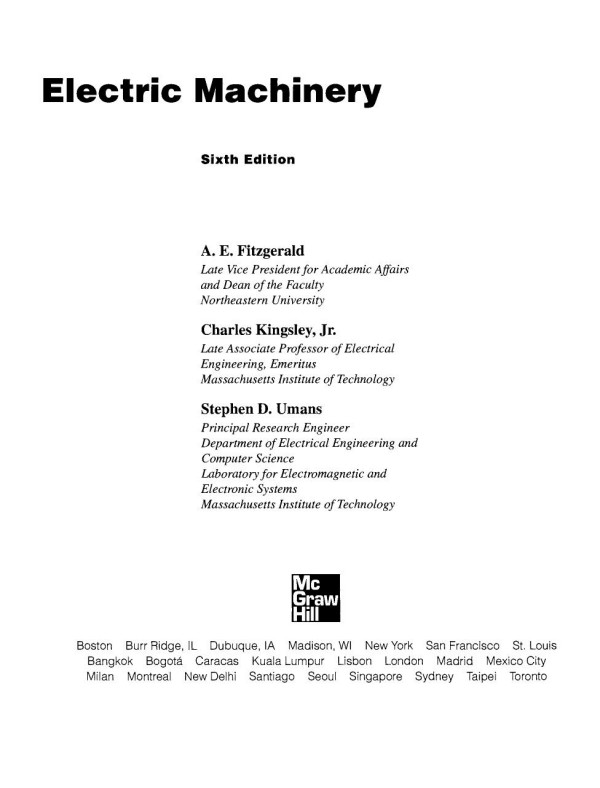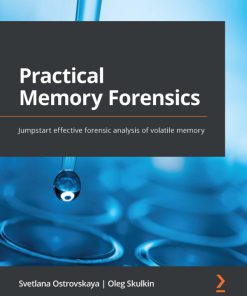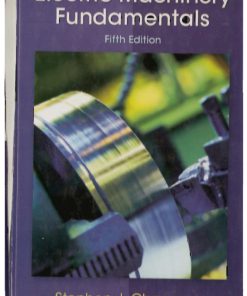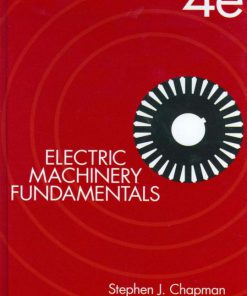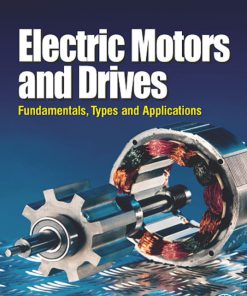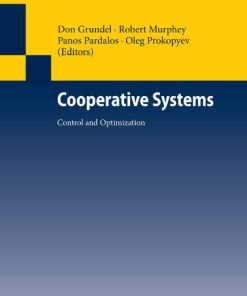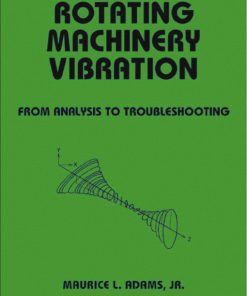Analysis of Electric Machinery and Drive Systems 3rd Edition by Paul Krause, Oleg Wasynczuk, Scott Sudhoff, Steven Pekarek 111802429X 9781118024294
$50.00 Original price was: $50.00.$25.00Current price is: $25.00.
Authors:Paul Krause; Oleg Wasynczuk; Scott D. Sudhoff; Steven Pekarek , Series:Electrical Engineering [83] , Tags:Technology & Engineering; Electrical; Electronics; General; Power Resources , Author sort:Krause, Paul & Wasynczuk, Oleg & Sudhoff, Scott D. & Pekarek, Steven , Ids:Google; 9781118524329 , Languages:Languages:eng , Published:Published:May 2013 , Publisher:John Wiley & Sons , Comments:Comments:Introducing a new edition of the popular reference on machine analysis Now in a fully revised and expanded edition, this widely used reference on machine analysis boasts many changes designed to address the varied needs of engineers in the electric machinery, electric drives, and electric power industries. The authors draw on their own extensive research efforts, bringing all topics up to date and outlining a variety of new approaches they have developed over the past decade. Focusing on reference frame theory that has been at the core of this work since the first edition, this volume goes a step further, introducing new material relevant to machine design along with numerous techniques for making the derivation of equations more direct and easy to use. Coverage includes: Completely new chapters on winding functions and machine design that add a significant dimension not found in any other text A new formulation of machine equations for improving analysis and modeling of machines coupled to power electronic circuits Simplified techniques throughout, from the derivation of torque equations and synchronous machine analysis to the analysis of unbalanced operation A unique generalized approach to machine parameters identification A first-rate resource for engineers wishing to master cutting-edge techniques for machine analysis, Analysis of Electric Machinery and Drive Systems is also a highly useful guide for students in the field.
Analysis of Electric Machinery and Drive Systems 3rd Edition by Paul Krause, Oleg Wasynczuk, Scott Sudhoff, Steven Pekarek – Ebook PDF Instant Download/Delivery. 111802429X, 9781118024294
Full download Analysis of Electric Machinery and Drive Systems 3rd Edition after payment
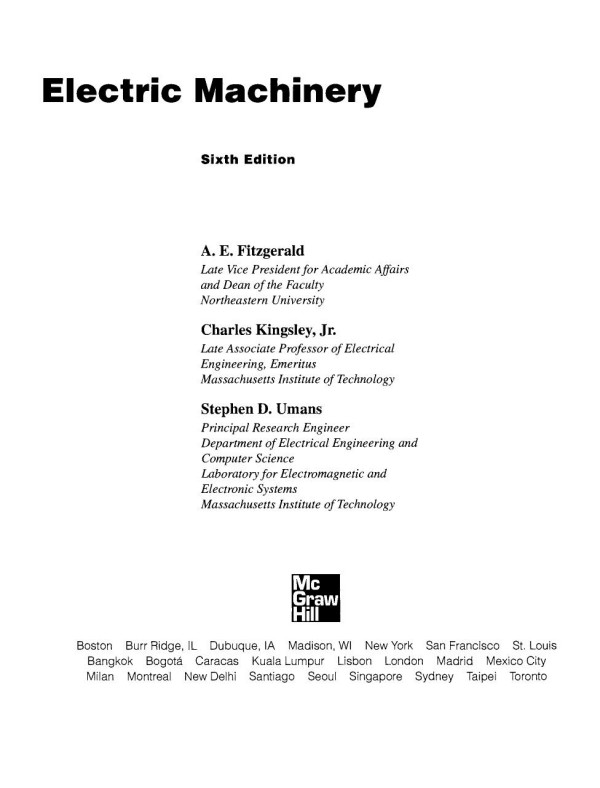
Product details:
ISBN 10: 111802429X
ISBN 13: 9781118024294
Author: Paul C. Krause, Oleg Wasynczuk, Scott D. Sudhoff, Steven Pekarek
“This theoretical text is a concise and condensed reference…suitable for a senior or graduate level course in electric machines. It is also recommended as an excellent reference guide…” (IEEE Electrical Insulation Magazine)
Analysis of Electric Machinery and Drive Systems 3rd Table of contents:
1 Theory of Electromechanical Energy Conversion
1.1 Introduction
1.2 Magnetically Coupled Circuits
Figure 1.2-1 Magnetically coupled circuits.
Linear Magnetic System
Figure 1.2-2 Equivalent circuit with coil 1 selected as reference coil.
Example 1A
Nonlinear Magnetic System
Figure 1.2-3 B–H curve for typical silicon steel used in transformers.
Figure 1.2-4 Magnetization curve.
Figure 1.2-5 f(λm) versus λm from Figure 1.2-4.
1.3 Electromechanical Energy Conversion
Energy Relationships
Figure 1.3-1 Block diagram of elementary electromechanical system.
Figure 1.3-2 Energy balance.
Figure 1.3-3 Electromechanical system with magnetic field.
Figure 1.3-4 Electromechanical system with electric field.
Energy in Coupling Fields
Figure 1.3-5 Stored energy and coenergy in a magnetic field of a singly excited electromagnetic device.
Graphical Interpretation of Energy Conversion
Figure 1.3-6 Graphical representation of electromechanical energy conversion for λ−i path A to B.
Electromagnetic and Electrostatic Forces
Figure 1.3-7 Graphical representation of electromechanical energy conversion for λ−i path B to A.
Figure 1.3-8 Graphical representation of electromechanical energy conversion for λ−i path A to B to A.
TABLE 1.3-1 Electromagnetic Force at Mechanical Input
TABLE 1.3-2 Electrostatic Force at Mechanical Input
Steady-State and Dynamic Performance of an Electromechanical System
Figure 1.3-9 Steady state operation of electromechanical system shown in Figure 1.3-3.
Figure 1.3-10 Dynamic performance of the electromechanical system shown in Figure 1.3-3 during step changes in the source voltage.
Figure 1.3-11 Dynamic performance of the electromechanical system shown in Figure 1.3-3 during step changes in the applied force.
Figure 1.3-12 System response shown in Figure 1.3-3.
Example 1B
Figure 1B-1 Elementary rotational electromechanical device. (a) End view; (b) cross-sectional view.
Figure 1B-2 Stator and rotor poles for constant currents.
1.4 Elementary AC Machines
Figure 1.4-1 A two-pole, two-phase induction machine.
Figure 1.4-2 A four-pole, two-phase induction machine.
Figure 1.4-3 A two-pole, three-phase induction machine.
Figure 1.4-4 A two-pole, two-phase, salient-pole synchronous machine.
Figure 1.4-5 A two-pole, three-phase, salient-pole synchronous machine.
Reference
Problems
Figure 1P-1 Two-winding, iron-core transformer.
Figure 1P-2 EE iron-core transformer.
Figure 1P-3 R–L circuit.
Figure 1P-4 Spring–mass–damper system.
Figure 1P-5 C-core inductor.
Figure 1P-6 UU-core transformer for Problem 14.
Figure 1P-7 UU-core transformer for Problem 21.
Figure 1P-8 Multicore system.
Figure 1P-9 Elementary four-pole, two-phase, salient-pole synchronous machine.
2 Distributed Windings in AC Machinery
2.1 Introduction
2.2 Describing Distributed Windings
Figure 2.2-1 Distributed winding stator.
Figure 2.2-2 Definition of position measurements.
Figure 2.2-3 P-pole machines.
Discrete Description of Distributed Windings
Figure 2.2-4 Slot structure.
Figure 2.2-5 Developed diagram.
Continuous Description of Distributed Windings
Symmetry Conditions on Conductor Distributions
Converting Between Discrete and Continuous Descriptions of Distributed Windings
End Conductors
Figure 2.2-6 End conductors.
Figure 2.2-7 Stator winding for a four-pole 36-slot machine.
Common Winding Arrangements
Figure 2.2-8 Winding arrangements. (a) Concentric winding arrangement; (b) consequent pole winding arrangement; (c) lap winding arrangement; (d) wave winding arrangement.
2.3 Winding Functions
Figure 2.3-1 Calculation of the winding function.
Example 2A
2.4 Air-Gap Magnetomotive Force
Figure 2A-1 Conductor distribution and winding functions.
Figure 2.4-1 Path of integration.
2.5 Rotating MMF
2.6 Flux Linkage and Inductance
Figure 2.6-1 Calculation of flux linkage.
2.7 Resistance
2.8 Voltage and Flux Linkage Equations for Distributed Winding Machines
Stator Voltage Equations
Synchronous Machine
Induction Machine
Reference
Problems
3 Reference-Frame Theory
3.1 Introduction
3.2 Background
3.3 Equations of Transformation: Change of Variables
Figure 3.3-1 Transformation for stationary circuits portrayed by trigonometric relationships.
3.4 Stationary Circuit Variables Transformed to the Arbitrary Reference Frame
Resistive Elements
Inductive Elements
Figure 3.4-1 Three-phase RL circuit. (a) Symmetrical transmission line; (b) wye connection.
Capacitive Elements
Example 3A
Figure 3A-1 Arbitrary reference-frame equivalent circuits for three-phase RL circuit described in Example 3A.
3.5 Commonly Used Reference Frames
3.6 Transformation of a Balanced Set
3.7 Balanced Steady-State Phasor Relationships
Example 3B
Figure 3B-1 Phasor representation for a three-phase balanced set.
3.8 Balanced Steady-State Voltage Equations
Example 3C
3.9 Variables Observed from Several Frames of Reference
Figure 3.9-1 Variables of stationary three-phase system in the stationary reference frame.
Figure 3.9-2 Variables of stationary three-phase system in synchronously rotating reference frame.
Figure 3.9-3 Variables of stationary three-phase system. First with ω = −ωe, then ω = 0, followed by a ramp change in reference-frame speed to ω = ωe.
3.10. Transformation Between Reference Frames
Figure 3.10-1 Transformation between two reference frames portrayed by trigonometric relationships.
3.11 Specialty Transformations
3.12 Space-Phasor Notation
References
Problems
4 Permanent-Magnet AC Machines
4.1 Introduction
4.2 Voltage and Torque Equations in Machine Variables
Figure 4.2-1 Two-pole, three-phase permanent-magnet ac machine.
4.3 Voltage and Torque Equations in Rotor Reference-Frame Variables
4.4 Analysis of Steady-State Operation
4.5 Brushless DC Motor
Figure 4.5-1 Torque-speed characteristics of a brushless dc motor with
Figure 4.5-2 Same as Figure 4.5-1 with Lmd = 0.6Lmq.
Figure 4.5-3 Free-acceleration characteristics of a brushless dc motor (ϕv = 0).
Figure 4.5-4 Torque-speed characteristics for free acceleration shown in Figure 4.5-3.
Figure 4.5-5 Dynamic performance of a brushless dc motor (ϕv = 0) during step changes in load torque with J=2×10−4 kg⋅m2.
4.6 Phase Shifting of Applied Voltages of a Permanent-Magnet AC Machine
Figure 4.5-6 Free-acceleration characteristics of a brushless dc motor supplied from a typical six-step voltage source inverter (ϕv = 0). Compare with Figure 4.5-3.
Figure 4.5-7 Torque-speed characteristics for free acceleration shown in Figure 4.5-6.
Figure 4.6-1 Torque-speed characteristics of a permanent-magnet ac machine with Lq = Ld.
4.7 Control of Stator Currents
Figure 4.6-2 Torque-speed characteristics of permanent-magnet ac machine with τs increased by a factor of 3 by decreasing rs.
Figure 4.6-3 Torque-speed characteristics of permanent-magnet ac machine with τs increased by a factor of 3 by increasing Ls.
References
Problems
5 Synchronous Machines
5.1 Introduction
5.2 Voltage Equations in Machine Variables
Figure 5.2-1 Two-pole, three-phase, wye-connected salient-pole synchronous machine.
5.3 Torque Equation in Machine Variables
5.4 Stator Voltage Equations in Arbitrary Reference-Frame Variables
5.5 Voltage Equations in Rotor Reference-Frame Variables
Figure 5.5-1 Equivalent circuits of a three-phase synchronous machine with the reference frame fixed in rotor: Park’s equations.
5.6 Torque Equations in Substitute Variables
5.7 Rotor Angle and Angle Between Rotors
5.8 Per Unit System
5.9 Analysis of Steady-State Operation
Example 5A
Figure 5A-1 Phasor diagram for conditions in Example 5A.
Figure 5A-2 Amplitude of stator current versus field current for conditions in Example 5A.
Figure 5.9-1 Phasor diagram with all losses neglected and zero power transfer.
Figure 5.9-2 Phasor diagram for generator operation.
5.10 Stator Currents Positive Out of Machine: Synchronous Generator Operation
Figure 5.10-1 Two-pole, three-phase, wye-connected salient-pole synchronous machine with currents defined positive out of the stator phase windings.
Figure 5.10-2 Equivalent circuits of a three-phase synchronous machine with the reference frame fixed in rotor: Park’s equations with currents defined positive out of the phase windings.
Example 5B
Figure 5.10-3 Phasor diagram for generator operation with currents defined positive out of the phase windings.
Dynamic Performance During a Sudden Change in Input Torque
TABLE 5.10.1 Hydro Turbine Generator
TABLE 5.10.2 Steam Turbine Generator
Figure 5.10-4 Dynamic performance of a hydro turbine generator during a step increase in input torque from zero to rated.
Figure 5.10-5 Torque versus rotor angle characteristics for the study shown in Figure 5.10-4.
Figure 5.10-6 Dynamic performance of a steam turbine generator during a step increase in input torque from 0% to 50% rated.
Figure 5.10-7 Torque versus rotor angle characteristics for the study shown in Figure 5.10-6.
Dynamic Performance During a Three-Phase Fault at the Machine Terminals
Figure 5.10-8 Dynamic performance of a hydro turbine generator during a three-phase fault at the terminals.
Figure 5.10-9 Torque versus rotor angle characteristics for the study shown in Figure 5.10-8.
Figure 5.10-10 Dynamic performance of a steam turbine generator during a three-phase fault at the terminals.
Figure 5.10-11 Torque versus rotor angle characteristics for the study shown in Figure 5.10-10.
Approximate Transient Torque versus Rotor Angle Characteristics
Comparison of Actual and Approximate Transient Torque–Angle Characteristics During a Sudden Change in Input Torque: First Swing Transient Stability Limit
Figure 5.10-12 Comparison of the dynamic torque–angle characteristic during a step increase in input torque from zero to rated with the calculated steady-state and approximate transient torque–angle characteristics—hydro turbine generator.
Figure 5.10-13 Same as Figure 5.10-12 for a steam turbine generator with input torque stepped from 0 to 50% rated.
Figure 5.10-14 Dynamic performance of a hydro turbine generator at the “first swing” transient stability limit.
Figure 5.10-15 Same as Figure 5.10-14 for a steam turbine generator.
Figure 5.10-16 Traces of flux linkages per second for a hydro turbine generator at the “first swing” transient stability limit.
Figure 5.10-17 Same as Figure 5.10-16 for a steam turbine generator.
Figure 5.10-18 Comparison of the dynamic torque–angle characteristic at the “first swing” transient stability limit with the approximate transient torque–angle curve: hydro turbine generator.
Figure 5.10-19 Same as Figure 5.10-18 for a steam turbine generator.
Comparison of Actual and Approximate Transient Torque–Angle Characteristics During a Three-Phase Fault at the Terminals: Critical Clearing Time
Figure 5.10-20 Comparison of the dynamic torque–angle characteristic during a three-phase fault with the calculated steady-state and approximate transient torque–angle characteristics: hydro turbine generator.
Figure 5.10-21 Same as Figure 5.10-20 for a steam turbine generator.
Figure 5.10-22 Traces of flux linkages per second for a hydro turbine generator during a three-phase fault at the terminals.
Equal-Area Criterion
Figure 5.10-23 Same as Figure 5.10-22 for a steam turbine generator.
Figure 5.10-24 Equal-area criterion for sudden change in input torque.
Figure 5.10-25 Equal-area criterion for a three-phase fault at the terminals.
5.11 Computer Simulation
Simulation in Rotor Reference Frame
Figure 5.11-1 Simulation of a synchronous machine in the rotor reference frame shown in block diagram form. (a) abc variables transformed directly to the rotor reference frame; (b) abc variables transformed to arbitrary reference frame then to rotor reference frame.
Simulation with Stator Voltage Equations in Arbitrary Reference Frame
Figure 5.11-2 Block diagram of the simulation of a synchronous machine with stator voltage equations in the arbitrary reference frame.
Simulation of Saturation
Figure 5.11-3 Saturation characteristics of a synchronous machine. (a) Open-circuited terminal voltage versus field current; (b) equivalent to characteristics shown in (a).
Figure 5.11-4 Saturation curve with flux linkages per second as variables.
Figure 5.11-5 Plot of obtained from Figure 5.11-4.
Figure 5.11-6 Saturation in both axes of a synchronous machine.
Figure 5.11-7 Simulation of saturation in both axes of a round rotor synchronous machine.
Simulation of Balanced Conditions
Simulation of Unbalanced Stator Conditions
References
Problems
Figure 5P-1 Two-pole, two-phase, salient-pole synchronous machine.
6 Symmetrical Induction Machines
6.1 Introduction
6.2 Voltage Equations in Machine Variables
Figure 6.2-1 Two-pole, three-phase, wye-connected symmetrical induction machine.
6.3 Torque Equation in Machine Variables
6.4 Equations of Transformation for Rotor Circuits
Figure 6.4-1 Transformation for rotating circuits portrayed by trigonometric relationships.
6.5 Voltage Equations in Arbitrary Reference-Frame Variables
Figure 6.5-1 Arbitrary reference-frame equivalent circuits for a three-phase, symmetrical induction machine.
6.6 Torque Equation in Arbitrary Reference-Frame Variables
6.7 Commonly Used Reference Frames
6.8 Per Unit System
6.9 Analysis of Steady-State Operation
Figure 6.9-1 Equivalent circuit for steady-state operation of a symmetrical induction machine.
Figure 6.9-2 Steady-state torque–speed characteristics of a singly excited induction machine.
Figure 6.9-3 Steady-state torque–speed characteristics of a singly excited induction machine for various values of rotor resistance.
Figure 6.9-4 Steady-state torque–speed characteristics of a singly excited symmetrical induction machine for various operating frequencies.
Example 6A
6.10 Free Acceleration Characteristics
TABLE 6.10-1 Induction Machine Parameters
Figure 6.10-1 Torque–speed characteristics during free acceleration: 3-hp induction motor.
Figure 6.10-2 Torque–speed characteristics during free acceleration: 50-hp induction motor.
Figure 6.10-3 Torque–speed characteristics during free acceleration: 500-hp induction motor.
Figure 6.10-4 Torque–speed characteristics during free acceleration: 2250-hp induction motor.
Figure 6.10-5 Machine variables during free acceleration of a 3-hp induction motor.
Figure 6.10-6 Machine variables during free acceleration of a 2250-hp induction motor.
Example 6B
Figure 6.10-7 Comparison of steady-state and free acceleration torque–speed characteristics: 500-hp induction motor.
Figure 6.10-8 Comparison of steady-state and free acceleration torque–speed characteristics: 2250-hp induction motor.
6.11 Free Acceleration Characteristics Viewed from Various Reference Frames
Figure 6.11-1 Free acceleration characteristics of a 10-hp induction motor in machine variables.
Figure 6.11-2 Free acceleration characteristics of a 10-hp induction motor in the stationary reference frame. ( is set to prior to t = 0.)
Figure 6.11-3 Free acceleration characteristics of a 10-hp induction motor in a reference frame fixed in rotor. ( is set to prior to t = 0.)
Figure 6.11-4 Free acceleration characteristics of a 10-hp induction motor in the synchronously rotating reference frame. ( is set to prior to t = 0.)
Figure 6.11-5 Free acceleration characteristics of a 10-hp induction motor in the arbitrary reference frame. First, ω = −ωe, then ω = 0; followed by a sinusoidal variation about zero of ω with amplitude ωe and frequency ωe, then the same variation about ωe. Finally, ω is set equal to ωe.
6.12 Dynamic Performance During Sudden Changes in Load Torque
Figure 6.12-1 Dynamic performance of a 3-hp induction motor during step changes in load torque from 0 to 11.87 N·m to 0.
Figure 6.12-2 Dynamic performance of a 2250-hp induction motor during step changes in load torque from 0 to 8.9 × 103 N·m to 0.
Figure 6.12-3 Torque versus speed for 2250-hp induction motor during load torque changes shown in Figure 6.12-2.
6.13 Dynamic Performance During a Three-Phase Fault at the Machine TERMINALS
Figure 6.13-1 Dynamic performance of a 3-hp induction motor during a three-phase fault at the terminals.
6.14 Computer Simulation in the Arbitrary Reference Frame
Figure 6.13-2 Dynamic performance of a 2250-hp induction motor during a three-phase fault at the terminals.
Figure 6.14-1 Simulation of a symmetrical three-phase induction machine in the arbitrary reference frame shown in block diagram form.
References
Problems
7 Machine Equations in Operational Impedances and Time Constants
7.1 Introduction
7.2 Park’s Equations in Operational Form
Figure 7.3-1 Equivalent circuit with two damper windings in the quadrature axis.
7.3 Operational Impedances and G(p) for a Synchronous Machine with Four Rotor Windings
Figure 7.3-2 Calculation of Xd(s) and G(s) for two rotor windings in direct axis. (a) Calculation of Xd(s); (b) calculation of G(s);
7.4 Standard Synchronous Machine Reactances
7.5 Standard Synchronous Machine Time Constants
TABLE 7.5-1 Standard Synchronous Machine Time Constants
7.6 Derived Synchronous Machine Time Constants
TABLE 7.6-1 Derived Synchronous Machine Time Constants
7.7 Parameters from Short-Circuit Characteristics
Figure 7.7-1 Plot of transient and subtransient components of the envelope of the short-circuit stator current.
7.8 Parameters from Frequency-Response Characteristics
Figure 7.8-1 Plot of Xq(s) and Xd(s) versus frequency for a solid iron synchronous machine.
Figure 7.8-2 Two-rotor winding approximation of Xq(s).
Figure 7.8-3 Three-rotor winding approximation of Xq(s).
Figure 7.8-4 Two-rotor winding direct-axis circuit with unequal coupling.
References
Problems
Figure 7P-1 Short-circuit stator currents.
8 Alternative Forms of Machine Equations
8.1 Introduction
8.2 Machine Equations to Be Linearized
Induction Machine
Synchronous Machine
8.3 Linearization of Machine Equations
Induction Machine
Synchronous Machines
Figure 8.3-1 Interconnection of small-displacement equations of a synchronous machine: Park’s equations.
8.4 Small-Displacement Stability: Eigenvalues
8.5 Eigenvalues of Typical Induction Machines
TABLE 8.5-1 Induction Machine Eigenvalues
Figure 8.5-1 Plot of eigenvalues for a 3-hp induction motor.
Figure 8.5-2 Plot of eigenvalues for a 2250-hp induction motor.
8.6 Eigenvalues of Typical Synchronous Machines
TABLE 8.6-1 Synchronous Machine Eigenvalues for Rated Conditions
8.7 Neglecting Electric Transients of Stator Voltage Equations
Induction Machine
Synchronous Machine
8.8 Induction Machine Performance Predicted with Stator Electric Transients Neglected
Free Acceleration Characteristics
Figure 8.8-1 Machine variables during free acceleration of a 2250-hp induction motor predicted with stator electric transients neglected.
Changes in Load Torque
Three-Phase Fault at Machine Terminals
Figure 8.8-2 Dynamic performance of a 2250-hp induction motor during a three-phase fault at the terminals predicted with stator electric transients neglected.
8.9 Synchronous Machine Performance Predicted with Stator Electric Transients Neglected
Changes in Input Torque
Three-Phase Fault at Machine Terminals
Figure 8.9-1 Dynamic performance of a steam turbine generator during a three-phase fault at the terminals predicted with stator electric transients neglected.
Figure 8.9-2 Torque versus rotor angle characteristics for the study shown in Figure 8.9-1.
Figure 8.10-1 Example canonical branch circuit element.
8.10 Detailed Voltage Behind Reactance Model
Figure 8.10-2 Machine/rectifier model using PVCC form.
Figure 8.10-3 Machine/rectifier model using PVVBR model.
Figure 8.10-4 Operational impedance of PVVBR model and PVVBR model with approximation of
8.11 Reduced Order Voltage Behind Reactance Model
Figure 8.10-5 Operational impedance of PVVBR model and PVVBR model with auxiliary damper winding to force
References
Problems
9 Unbalanced Operation and Single-Phase Induction Machines
9.1 Introduction
9.2 Symmetrical Component Theory
9.3 Symmetrical Component Analysis of Induction Machines
9.4 Unbalanced Stator Conditions of Induction Machines: Reference-Frame Analysis
Unbalanced Machine Variables in the Arbitrary Reference Frame
Phasor Relationships
9.5 Typical Unbalanced Stator Conditions of Induction Machines
Unbalanced Source Voltages
Figure 9.5-1 Stator circuit of induction machine.
Figure 9.5-2 Stator circuit with impedance in series with as winding.
Unbalanced Stator Impedances
Figure 9.5-3 Stator circuit with provisions for switching ias.
Open-Circuited Stator Phase
9.6 Unbalanced Rotor Conditions of Induction Machines
Unbalanced Machine Variables in the Arbitrary Reference Frame
Phasor Relationships
9.7 Unbalanced Rotor Resistors
Figure 9.7-1 Rotor circuits with unbalanced external resistors.
Figure 9.7-2 Starting characteristics of a 10-hp induction motor with unbalanced rotor resistors and 1.0 pu torque load; R’ar = 0.2 pu, R’br = 0.1 pu, and R’cr = 0.05 pu.
Figure 9.7-3 Steady-state torque-speed characteristics of a 10-hp induction motor with unbalanced rotor resistors as given in Figure 9.7-2.
9.8 Single-Phase Induction Machines
Voltage Equations in Arbitrary Reference Frame
Figure 9.8-1 A two-pole two-phase symmetrical induction machine.
Unbalanced Machine Variables in Arbitrary Reference Frame
Phasor Relationships
Unbalanced Stator Impedances
Open-Circuited Stator Phase
Figure 9.8-2 Steady-state torque versus speed characteristics for a single-phase induction motor.
Operating Characteristics of Single-Phase Induction Motors
Figure 9.8-3 Steady-state torque versus speed characteristics with a capacitor in series with one winding of the two-phase induction machine.
Figure 9.8-4 Average steady-state torque versus speed characteristics of a capacitor-start single-phase induction motor.
Figure 9.8-5 Free-acceleration characteristics of a capacitor-start single-phase induction motor.
Figure 9.8-6 Torque versus speed characteristics for Figure 9.8-5.
9.9 Asynchronous and Unbalanced Operation of Synchronous Machines
Figure 9.9-1 Free acceleration of synchronous motor with H = 1.0 second and no load.
Motor Starting
Figure 9.9-2 Steady-state torque-speed characteristics of the same synchronous motor depicted in Figure 9.9-1.
Figure 9.9-3 Pulling into step after applying 1.0 pu field voltage with H = 4.0 seconds and TL = 0.2 pu.
Pole Slipping
Figure 9.9-4 Pole slipping of hydro turbine generator.
Line-to-Neutral Fault
Figure 9.9-5 Dynamic performance of a steam turbine generator during a line-to-neutral fault at the terminals.
Line-to-Line Fault
Line-to-Line-to-Neutral Fault
Figure 9.9-6 Dynamic performance of a steam turbine generator during a line-to-line fault at the terminals.
Figure 9.9-7 Dynamic performance of a steam turbine generator during a line-to-line-to-neutral fault at the terminals.
References
Problems
Figure 9P-1 Equivalent circuit for single-phase winding.
10 DC Machines and Drives
10.1 Introduction
10.2 Elementary DC Machine
Figure 10.2-1 Elementary two-pole dc machine.
Figure 10.2-2 Commutation of the elementary dc machine.
Figure 10.2-3 A dc machine with parallel armature windings.
Figure 10.2-4 Same as Figure 10.2-3, with rotor advanced approximately 22.5° counterclockwise.
Figure 10.2-5 Idealized dc machine with uniformly distributed rotor winding.
10.3 Voltage and Torque Equations
Figure 10.3-1 Equivalent circuit of dc machine.
Figure 10.4-1 Equivalent circuit for separate field and armature excitation.
10.4 Basic Types of DC Machines
Separate Winding Excitation
Figure 10.4-2 Equivalent circuit of a shunt-connected dc machine.
Shunt-Connected DC Machine
Figure 10.4-3 Steady-state operating characteristics of a shunt-connected dc machine with constant source voltage.
Series-Connected DC Machine
Figure 10.4-4 Equivalent circuit for a series-connected dc machine.
Figure 10.4-5 Steady-state torque–speed characteristics of a series-connected dc machine.
Figure 10.4-6 Equivalent circuit of a compound dc machine.
Compound-Connected DC Machine
Example 10A
Example 10B
10.5 Time-Domain Block Diagrams and State Equations
Shunt-Connected DC Machine
Figure 10.5-1 Time-domain block diagram of a shunt-connected dc machine.
Permanent-Magnet DC Machine
Figure 10.5-2 Time-domain block diagram of a permanent-magnet dc machine.
10.6 Solid-State Converters for DC Drive Systems
Single-Phase AC/DC Converters
Three-Phase AC/DC Converters
Figure 10.6-1 Typical single-phase phase-controlled ac/dc converters. (a) Half-wave converter; (b) semi-converter; (c) full converter; and (d) dual converter.
DC/DC Converters
Figure 10.6-2 Typical three-phase, phase-controlled ac/dc converters. (a) Half-wave converter; (b) semi-converter; (c) dull converter; and (d) dual converter.
10.7 One-Quadrant DC/DC Converter Drive
One-Quadrant DC/DC Converter
Figure 10.6-3 Typical dc/dc converters. (a) One quadrant; (b) two quadrant; and (c) four quadrant.
Figure 10.7-1 One-quadrant chopper drive system.
Figure 10.7-2 Switching logic for voltage control of one-quadrant chopper drive shown in Figure 10.7-1.
Continuous-Current Operation
Figure 10.7-3 Typical waveforms for continuous-current steady-state operation of a one-quadrant chopper drive.
Discontinuous-Current Operation
Figure 10.7-4 Typical waveforms for discontinuous-current steady-state operation of a one-quadrant chopper drive.
Average-Value Analysis
Figure 10.7-5 Averaging interval for ti + 1 ≤ t ≤ ti + 1 + ki + 1T; continuous-current operation of one-quadrant chopper drive.
Figure 10.7-6 Averaging interval for ti + 1 + ki + 1T ≤ t ≤ ti + 1 + kiT; continuous-current operation of one-quadrant chopper drive.
Figure 10.7-7 versus t for va shown in Figure 10.7-5 and Figure 10.7-6.
Figure 10.7-8 Comparison of and for k = 0.5 + 0.5 sin[r(t)t].
Operating Characteristics
Figure 10.7-9 Average-value model for a one-quadrant chopper drive.
Figure 10.7-10 Operating characteristics of a one-quadrant chopper drive.
Figure 10.7-11 Part of Figure 10.7-10 with expanded time scale.
Figure 10.7-12 Same as Figure 10.7-10 using the average-value model shown in Figure 10.7-9.
Example 10C
Figure 10.7-13 Dynamic average of variables shown in Figure 10.7-10.
Figure 10C-1 Dynamic averaging of va for a change in source voltage vS.
Figure 10C-2 versus t for va shown in Figure 10C-1.
Figure 10C-3 Comparison of and for υS = 5 + 5 sin[r(t)t].
10.8 Two-Quadrant DC/DC Converter Drive
Figure 10.8-1 Two-quadrant chopper drive system.
Figure 10.8-2 Typical waveforms for steady-state operation of a two-quadrant chopper drive.
Figure 10.8-3 Average-value model of a two-quadrant chopper drive.
Figure 10.9-1 Four-quadrant chopper drive system.
10.9 Four-Quadrant DC/DC Converter Drive
Figure 10.9-2 Typical waveforms for steady-state operation of a four-quadrant chopper drive.
10.10 Machine Control with Voltage-Controlled DC/DC Converter
Figure 10.10-1 Speed control of dc machine with voltage-controlled dc/dc converter.
Speed Control: Voltage-Controlled DC/DC Converter
Figure 10.10-2 Feedforward voltage control.
Speed Control: Voltage-Controlled DC/DC Converter with Voltage Feedforward Control
10.11 Machine Control with Current-Controlled DC/DC Converter
Current-Controlled Four-Quadrant DC/DC Converter
Figure 10.11-1 Demodulator: KiS to Kia.
Figure 10.11-2 Hysteresis-type current controller of a current-controlled four-quadrant chopper.
Figure 10.11-3 Typical response of a current-controlled four-quadrant chopper for step increase in from zero.
Figure 10.11-4 Acceleration from stall of dc drive with currents-controlled dc/dc converter.
Figure 10.11-5 Torque versus speed for acceleration shown in Figure 10.11-4.
Figure 10.11-6 Speed control of dc machine with current-controlled dc/dc converter: current tracking operation.
Speed Control: Current-Controlled DC/DC Converter
References
Problems
11 Semi-Controlled Bridge Converters
11.1 Introduction
11.2 Single-Phase Load Commutated Converter
Figure 11.2-1 Single-phase full-bridge converter.
Operation without Commutating Inductance or Firing Delay
Figure 11.2-2 Single-phase, full-bridge converter operation for constant output current without lc and firing delay.
Operation with Commutating Inductance and without Firing Delay
Figure 11.2-3 Single-phase, full-bridge converter operation for constant output current with lc and without firing delay.
Operation without Commutating Inductance and with Firing Delay
Operation with Commutating Inductance and Firing Delay
Figure 11.2-4 Single-phase, full-bridge converter operation for constant output current without lc and with firing delay.
Figure 11.2-5 Single-phase, full-bridge converter operation for constant output current with lc and firing delay.
Figure 11.2-6 Average-value equivalent circuit for a single-phase full-bridge converter.
Figure 11.2-7 Single-phase, full-bridge converter operation with RL load. (a) α = 0°; (b) α = 45°; (c) α ≈ 90°, discontinuous operation.
Modes of Operation
Figure 11.2-8 Single-phase, full-bridge converter operation with RL and an opposing dc source connected in series across the converter terminals. (a) α = 0°; (b) α = 60°.
Figure 11.2-9 Single-phase, full-bridge converter operation with RL and an aiding dc source connected in series across the converter terminals. (a) α = 108°; (b) α = 126°.
11.3 Three-Phase Load Commutated Converter
Figure 11.3-1 Three-phase full-bridge converter.
Figure 11.3-2 Three-phase, full-bridge converter operation with RL load. (a) α = 0°; (b) α = 45°; (c) α = 90°.
Modes of Operation
Figure 11.3-3 Three-phase, full-bridge converter operation with RL and an opposing dc source connected in series across the converter terminals. (a) α = 0°; (b) α = 35°.
Figure 11.3-4 Three-phase, full-bridge converter operation with RL and an aiding dc source connected in series across the converter terminals. (a) α = 140°; (b) α = 160°.
Analysis and Average-Value Model
Figure 11.3-5 Average-value model of three-phase full-bridge converter.
11.4 Conclusions and Extensions
Figure 11.3-6 Comparison of average-value dynamic response with actual response.
References
Problems
12 Fully Controlled Three-Phase Bridge Converters
12.1 Introduction
12.2 The Three-Phase Bridge Converter
Figure 12.2-1 The three-phase bridge converter topology.
Figure 12.2-2 One phase leg.
Figure 12.2-3 Phase leg equivalent circuits. (a) Upper switch on; ixs > 0. (b) Upper switch on; ixs 0. (e) Lower switch on; ixs 0. (h) Neither switch on; ixs < 0. (i) Neither switch on; ixs = 0.
TABLE 12.2-1 Converter Voltages and Currents
12.3 Six-Step Operation
Figure 12.3-1 Line-to-line voltages for six-step operation.
Figure 12.3-2 Line-to-neutral voltage for six-step operation.
Figure 12.3-3 Frequency spectrum of six-step operation.
Figure 12.3-4 Voltage and current waveforms for a six-stepped converter feeding an RL load.
Figure 12.3-5 Comparison of a-phase voltage to q- and d-axis voltage.
Example 3A
12.4 Six-Step Modulation
Figure 12.4-1 Six-step modulation control schematic (deadtime logic not shown).
Figure 12.4-2 Six-step modulation control signals.
Figure 12.4-3 Voltage and current waveforms for six-step modulated converter feeding an RL load.
12.5 Sine-Triangle Modulation
Figure 12.5-1 Sine-triangle modulation control schematic (deadtime logic not shown).
Figure 12.5-2 Operation of a sine-triangle modulator.
Figure 12.5-3 Voltage and current waveforms using sine-triangle modulation.
Figure 12.5-4 Overmodulation.
Figure 12.5-5 Voltage and current waveforms during overmodulated operation.
12.6 Extended Sine-Triangle Modulation
12.7 Space-Vector Modulation
Figure 12.7-1 Space-vector diagram.
TABLE 12.7-1 Modulation Indices versus State
TABLE 12.7-2 State Sequence
12.8 Hysteresis Modulation
Figure 12.8-1 State transition diagram.
Figure 12.8-2 Allowable current band.
Figure 12.8-3 Voltage and current waveforms using a hysteresis modulator.
12.9 Delta Modulation
12.10 Open-Loop Voltage and Current Regulation
Figure 12.10-1 Voltage regulation using a six-step modulator.
Figure 12.10-2 Voltage regulation using an extended sine-triangle modulator.
12.11 Closed-Loop Voltage and Current Regulation
Figure 12.11-1 Synchronous regulator.
Figure 12.11-2 Voltage-source modulator based current regulator.
References
Problems
Figure 12P-1 The a-phase line-to-ground voltage of a three-phase bridge converter.
Figure 12P-2 Circuit than can be used to avoid shoot-through.
13 Induction Motor Drives
13.1 Introduction
13.2 Volts-per-Hertz Control
Figure 13.2-1 Elementary volts-per-hertz drive.
Figure 13.2-2 Performance of elementary volts-per-hertz drive.
Figure 13.2-3 Compensated volts-per-hertz drive.
Figure 13.2-4 Performance of compensated volts-per-hertz drive.
Figure 13.2-5 Start-up performance of compensated volts-per-hertz drive.
13.3 Constant Slip Current Control
Figure 13.3-1 Constant slip frequency drive.
Figure 13.3-2 Performance of constant slip frequency drive (maximum torque-per-amp).
Figure 13.3-3 Performance of constant slip frequency drive (maximum efficiency).
Figure 13.3-4 Start-up performance of constant slip controlled drive.
Figure 13.3-5 Speed control.
13.4 Field-Oriented Control
Figure 13.4-1 Torque on a current loop.
Figure 13.4-2 Torque production in an induction motor.
Figure 13.4-3 Generic rotor flux oriented control.
13.5 Direct Field-Oriented Control
Figure 13.5-1 Rotor flux calculator.
Figure 13.5-2 Direct field-oriented control.
13.6 Robust Direct Field-Oriented Control
Figure 13.6-1 Flux control loop.
Figure 13.6-2 Torque control loop.
Figure 13.6-3 Robust direct rotor field oriented control.
Figure 13.6-4 Start-up performance of robust direct field oriented drive.
13.7 Indirect Rotor Field-Oriented Control
Figure 13.7-1 Indirect rotor field oriented control.
Figure 13.7-2 Start-up performance of indirect field oriented drive.
Figure 13.7-3 Start-up performance of indirect field oriented drive with errors in estimated parameter values.
Figure 13.8-1 Direct torque control of an induction motor.
13.8 Direct Torque Control
Figure 13.8-2 Stator flux and achievable voltage vectors.
TABLE 13.8-1 Achievable Voltage Vectors and Corresponding Switching State
TABLE 13.8-2. Switching Table for Direct Torque Control
Figure 13.8-3 Step response of an induction motor with DTC.
13.9 Slip Energy Recovery Drives
Figure 13.9-1 Circuit/block diagram of a slip energy recovery drive system.
Figure 13.9-2 Feedforward control for a slip energy recovery drive system.
13.10 Conclusions
References
Problems
14 Permanent-Magnet AC Motor Drives
14.1 Introduction
Figure 14.1-1 Permanent-magnet ac motor drive.
14.2 Voltage-Source Inverter Drives
Figure 14.2-1 Permanent-magnet ac motor drive circuit.
14.3 Equivalence of Voltage-Source Inverters to an Idealized Source
Figure 14.3-1 Electrical diagram of a permanent-magnet ac machine.
Figure 14.3-2 Semiconductor switching signals.
Figure 14.3-3 Steady-state performance of a six-stepped permanent-magnet ac motor drive.
Figure 14.3-4 Steady-state performance of a six-step-modulated permanent-magnet ac motor drive.
Figure 14.3-5 Steady-state performance of sine-triangle-modulated permanent-magnet ac motor drive.
14.4 Average-Value Analysis of Voltage-Source Inverter Drives
14.5 Steady-State Performance of Voltage-Source Inverter Drives
14.6 Transient and Dynamic Performance of Voltage-Source Inverter Drives
Figure 14.5-1 Steady-state voltage-source inverter-based permanent-magnet ac motor drive characteristics with and without commutating inductance.
Figure 14.6-1 Start-up performance of a sine-triangle-modulated permanent-magnet ac motor drive as calculated using a waveform-level model.
Figure 14.6-2 Start-up performance of a sine-triangle-modulated permanent-magnet ac motor drive as calculated using an average-value model.
Figure 14.6-3 Start-up performance of a sine-triangle-modulated permanent-magnet ac motor drive as calculated using a linearized model.
Figure 14.6-4 Response of a sine-triangle-modulated permanent-magnet ac motor drive to a step change in duty cycle as calculated using a waveform-level model.
14.7 Case Study: Voltage-Source Inverter-Based Speed Control
Figure 14.6-5 Response of a sine-triangle-modulated permanent-magnet ac motor drive to a step change in duty cycle as calculated using a linearized model.
TABLE 14.7-1 Drive System Parameters
Figure 14.7-1 Speed control system.
Figure 14.7-2 Frequency response of the open-loop permanent-magnet ac motor drive.
Figure 14.7-3 Frequency response of the compensated permanent-magnet ac motor drive.
Figure 14.7-4 Frequency response of the closed-loop permanent-magnet ac motor drive.
Figure 14.7-5 Start-up response of the closed-loop permanent-magnet ac motor drive.
14.8 Current-Regulated Inverter Drives
Figure 14.8-1 Hysteresis-modulated current-regulated drive control.
Figure 14.8-2 Steady-state performance of a hysteresis-modulated current-regulated permanent-magnet ac motor drive.
Figure 14.8-3 A sine-triangle-modulator based current regulator.
Example 14A
Figure 14A-1 Step response of a feedforward sine-triangle-modulated current-regulated permanent-magnet ac motor drive.
14.9 Voltage Limitations of Current-Regulated Inverter Drives
14.10 Current Command Synthesis
Figure 14.9-1 Response of hysteresis-modulated current-regulated permanent-magnet ac motor drive to step decrease in dc inverter voltage.
Figure 14.10-1 Selection of q- and d-axis currents.
14.11 Average-Value Modeling of Current-Regulated Inverter Drives
14.12 Case Study: Current-Regulated Inverter-Based Speed Controller
Figure 14.12-1 Current-regulated-inverter based speed control.
Figure 14.12-2 Start-up response of current-regulated-inverter based speed control system.
References
Problems
15 Introduction to the Design of Electric Machinery
15.1 Introduction
Figure 15.1-1 Surface-mounted permanent-magnet synchronous machine.
15.2 Machine Geometry
Figure 15.2-1 Dimensions of surface-mounted permanent-magnet synchronous machine.
Figure 15.2-2 Slot and tooth dimensions.
Figure 15.2-3 Rectangular slot approximation.
15.3 Stator Windings
15.4 Material Parameters
Figure 15.4-1 B–H and M–H characteristics of PM material.
TABLE 15.4-1 Magnetic Steels
TABLE 15.4-2 Conductors
TABLE 15.4-3 Permanent Magnets
15.5 Stator Currents and Control Philosophy
15.6 Radial Field Analysis
Stator MMF
Radial Field Variation
Figure 15.6-1 Thin sector of machine.
Air-Gap MMF Drop
Permanent-Magnet MMF
Figure 15.6-2 Radial magnetization.
Solution for Radial Flux Density
15.7 Lumped Parameters
15.8 Ferromagnetic Field Analysis
Figure 15.8-1 Backiron flux calculation.
Figure 15.8-2 Backiron flux linkage.
Figure 15.8-3 Flux density in rotor backiron.
15.9 Formulation of Design Problem
Design Space
Design Metrics
Design Constraints
Design Fitness
15.10 Case Study
TABLE 15.10-1 Fixed Design Specifications
TABLE 15.10-2 Parameter Ranges
Figure 15.10-1 Design evolution. (a) Mass objective; (b) loss objective.
Figure 15.10-2 Mass-loss tradeoff.
TABLE 15.10-3 Machine Design 1 from Pareto-Optimal Front
Figure 15.10-3 Machine design 1 cross section.
15.11 Extensions
Figure 15.10-4 Flux density waveforms.
Acknowledgments
TABLE 15.10-4 Machine Design 100 from Pareto-Optimal Front
References
Problems
Back Matter
Appendix A Trigonometric Relations, Constants and Conversion Factors, and Abbreviations
A.1 Basic Trigonometric Relations
A.2 Three-Phase Trigonometric Relations
A.3 Constants and Conversion Factors
A.4 Abbreviations
Appendix B Carter’s Coefficient
Figure B-1 Carter’s coefficient.
Appendix C Leakage Inductance
Figure C-1 Slot leakage inductance.
Figure C-2 End leakage inductance.
Figure C-3 Primary slot permeance
Figure C-4 End leakage permeance
Figure C-5 End winding permeance: interior path
Figure C-6 End winding permeance: interior path
People also search for Analysis of Electric Machinery and Drive Systems 3rd:
analysis of electric machinery and drive systems
analysis of electric machinery
analysis of electric machinery krause
analysis of electric machinery and drive systems third edition
You may also like…
eBook PDF
Principles of Electric Machines and Power Electronics 3rd Edition by Sen 111807887X 9781118078877

